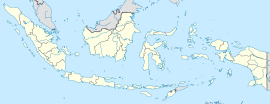
North Sulawesi is a province of Indonesia. It is mainly located on the Minahasa Peninsula of the island of Sulawesi, south of the Philippines and southeast of Sabah, Malaysia, but also includes various small archipelagoes situated between the Minahasa Peninsula and the southern Philippines. It borders the Philippine province of Davao Occidental and Soccsksargen regions of the Philippines to the north, the Maluku Sea to the east, Gorontalo and Celebes Sea to the west and the Gulf of Tomini to the southwest. The province's furthest extent, the outlying and isolated island of Miangas to its north, is the northernmost island of Indonesia.
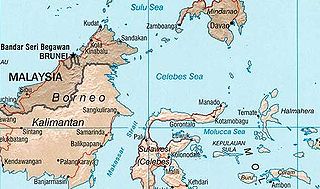
The Celebes Sea or Sulawesi Sea of the western Pacific Ocean is bordered on the north by the Sulu Archipelago and Sulu Sea and Mindanao Island of the Philippines, on the east by the Sangihe Islands chain, on the south by Sulawesi's Minahasa Peninsula, and the west by northern Kalimantan in Indonesia. It extends 420 miles (675 km) north-south by 520 mi (840 km) east-west and has a total surface area of 110,000 square miles (280,000 km2), to a maximum depth of 20,300 feet (6,200 m). South of the Cape Mangkalihat, the sea opens southwest through the Makassar Strait into the Java Sea.

The Minahasans or Minahassa are an indigenous ethnic group from the North Sulawesi province of Indonesia, formerly known as North Celebes. The Minahasa people sometimes refer to themselves as Manado people. Although the Minahasan pre-Christian creation myth entails some form of ethnic unification, before the nineteenth century the Minahasa region was in no way unified. Instead, a number of politically independent groups (walak) existed together, often in a permanent state of conflict.

Manado is the capital city of the Indonesian province of North Sulawesi. It is the second largest city in Sulawesi after Makassar, with the 2020 census giving a population of 451,916, and the official estimates for mid 2023 showing 458,582 inhabitants, distributed over a land area of 157.26 km2. The Manado metropolitan area had a population of 1,377,815 as of mid 2023. The city is situated on the Bay of Manado, and is surrounded by a mountainous area.
Indonesians in the Philippines consist of expatriates and immigrants from Indonesia residing in the Philippines, and their descendants. Among them were many formerly stateless people, legally called Persons of Indonesian descent (PID), whom the United Nations and the governments of the two countries helped to acquire citizenship.

The Sangihe Islands – Indonesian: Kepulauan Sangihe – are a group of islands that constitute two regencies within the province of North Sulawesi, in northern Indonesia, the Sangihe Islands Regency and the Sitaro Islands Regency. They are located northeast of Sulawesi between the Celebes Sea and the Molucca Sea, roughly halfway between Sulawesi and Mindanao, in the Philippines; the Sangihes form the eastern limit of the Celebes Sea. The islands combine to total 813 square kilometers (314 sq mi), with many of the islands being actively volcanic with fertile soil and mountains.

The Catholic Church in Indonesia is part of the worldwide Catholic Church, under the spiritual leadership of the pope in Rome. Catholicism is one of the six approved religions in Indonesia, the others being Islam, Protestantism, Hinduism, Buddhism, and Confucianism. According to official figures, Catholics made up 3.12 percent of the population in 2018. The number of Catholics is, therefore, more than 8.3 million. Indonesia is primarily Muslim, but Catholicism is the dominant faith in certain areas of the country.

The Island of Palmas Case was a territorial dispute over the Island of Palmas between the Netherlands and the United States which was heard by the Permanent Court of Arbitration. Palmas was declared to be a part of the Netherlands East Indies and is now part of Indonesia.

Bitung, officially the City of Bitung, is a coastal city at the north-eastern edge of the island of Sulawesi in Indonesia. Bitung is located in the province of North Sulawesi, and faces Lembeh Island, and the Lembeh Strait, which is known for its colourful marine life, in particular sea slugs. Bitung has a population of 187,932 at the 2010 Census, making it the second most populated city in the province after the capital Manado, rising to 225,134 at the 2020 Census; the official estimate as at mid 2023 was 232,440.

The red-and-blue lory is a small, strikingly-colored parrot endemic to Indonesia. The species inhabits a single island, Karakelong, in the Indonesian archipelago, although it was formerly found on the Sangihe Islands and other parts of the Talaud Islands.
The Sangiric languages are a subgroup of the Austronesian languages spoken in North Sulawesi, Indonesia and several small islands to the north which belong to the Philippines. They are classified as a branch of the Philippine subgroup.
The Southern Asia-Pacific Division (SSD) of Seventh-day Adventists is a sub-entity of the General Conference of Seventh-day Adventists, which coordinates the Church's activities in the nations of Bangladesh, Brunei, Burma, Cambodia, Indonesia, Laos, Malaysia, Pakistan, the Philippines, Singapore, Sri Lanka, Thailand, East Timor, and Vietnam. Its headquarters is in Silang, Cavite, Philippines. The Division has 1,695,552 members as of June 30, 2021
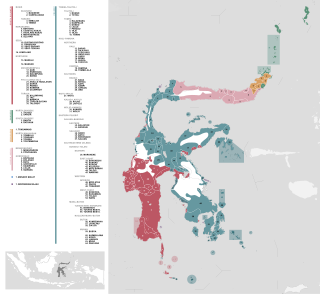
On the Indonesian island of Sulawesi, 114 native languages are spoken, all of which belong to the Malayo-Polynesian subgroup of the Austronesian language family. With a total number of 17,200,000 inhabitants, Sulawesi displays a high linguistic diversity when compared with the most densely populated Indonesian island Java, which hosts 4–8 languages spoken by 145,100,000 inhabitants.

The Sangihe Islands Regency is a regency of North Sulawesi Province, Indonesia. It comprises a group of islands situated to the North of Sulawesi. It covers a land area of 736.98 km2, and had a population of 126,100 at the 2010 census and 139,262 at the 2020 census; the official estimate as at mid 2023 was 140,614. The principal island is also named Sangihe, on which lies the main town of Tahuna. Minor island groups within the Regency include the Marore group considerably to the north of Sangihe Island, the Tatoareng group to the south, and the Nusa Tabukan group off the northeast coast of Sangihe Island. It borders the Philippines in the north, making it one of Indonesia's border regions.
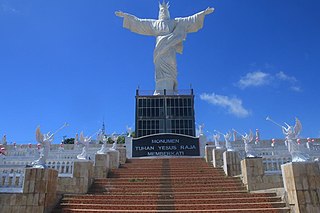
The Talaud Islands Regency is a regency of North Sulawesi province, Indonesia. The Talaud Islands form an archipelago situated to the northeast of the Minahasa Peninsula, with a land area of 1,251.02 km2. It had a population of 83,434 at the 2010 Census, increasing to 94,521 at the 2020 Census; the official estimate as of mid-2023 was 97,312.
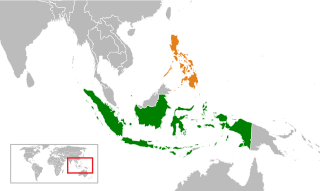
Indonesia–Philippine relations are the bilateral relations between Indonesia and the Philippines. The two countries established diplomatic relations on November 24, 1949. Since then, both countries enjoy cordial bilateral relationship in spirit of kinship. The two countries are considered allies and it is considered as one of the most important bilateral relationships in ASEAN. Both countries have established embassies in each capitals, Indonesia has their embassy in Manila and consulate general in Davao City, while the Philippines has their embassy in Jakarta and consulate general in Manado. High rank stately visits have been conducted for years.
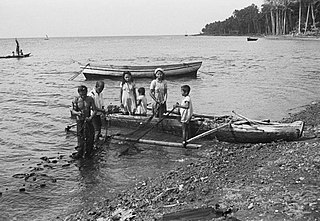
Sangirese or Sangihe people are one of the native people of the Sangir Islands in the northern chain of islands in Sulawesi and the southern part of Mindanao. The Sangirese people are fishermen and nutmeg growers in their home areas and also work as wage labourers in industrial crops enterprises in Bolaang Mongondow Regency and Minahasa Regency.

The border between Indonesia and the Philippines consists of a maritime boundary mainly on the Celebes Sea that separates the two Southeast Asian countries as defined through a pact that was signed by both parties in 2014. The border is also the Exclusive Economic Zone (EEZ) boundary between Indonesia and the Philippines, which is delimited through eight geographic coordinate points. It has a length of 1,162.2 kilometres dividing across the Celebes Sea to the Philippine Sea.

Londe or londi is a traditional boat from North Sulawesi, Indonesia. They are thought to have existed since 1500s, developed from ancient Sangir islands boat called bininta which is now enshrined in the symbol of the region of Sangir Islands District.
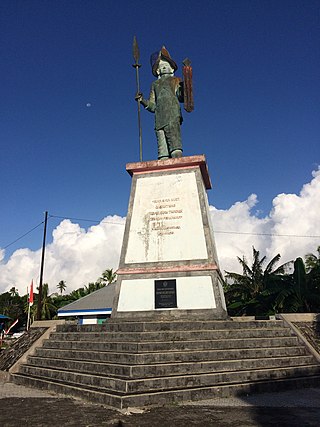
Don Jugov Santiago, popularly known as Bataha Santiago, was the third king of Manganitu Kingdom in Sangihe Islands of modern-day Indonesia. He ruled from 1670 until his death in 1675 and is known for his opposition to opening relations with the Dutch, which resulted in his deposition and execution. He was awarded title National Hero of Indonesia in 2023.

